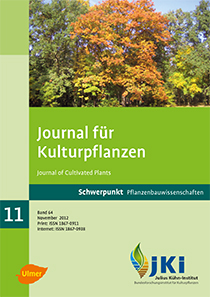Potato black leg as affected by seed tuber contamination, seed tuber size and plant density
DOI:
https://doi.org/10.5073/JfK.2012.11.01Keywords:
Solanum tuberosum, Potato black leg, seed tuber infection, seed tuber size, plant densityAbstract
Black leg and tuber soft rot are important bacterial diseases in potato production. A reduction is possible only through preventive measures. The present study examines how location, initial contamination of seed tubers, seed tuber size and plant density affect symptom development in the field. The study also assesses how the initial contamination affects emergence, ground cover, stem and tuber development, tuber yield, starch content and starch yield. The results show that the use of healthy and small seed tubers planted in low density can reduce the infection with blackleg. A high initial contamination had on one location negative effects already on emergence and ground cover shortly after emergence. In general, strongly contaminated seed tubers produced less stems and tubers per plant, and lower tuber yield, starch content and starch yield. The disease severity had negative effects on the yield per plant, because less tubers were formed and they stayed smaller.
Downloads
Published
Issue
Section
License
The content of the journal is licensed under the Creative Commons Attribution 4.0 License. Any user is free to share and adapt (remix, transform, build upon) the content as long as the original publication is attributed (authors, title, year, journal, issue, pages).
The copyright of the published work remains with the authors. The authors grant the Journal of Cultivated Plants, the Julius Kühn-Institut and the OpenAgrar repository the non-exclusive right to distribute and exploit the work.







